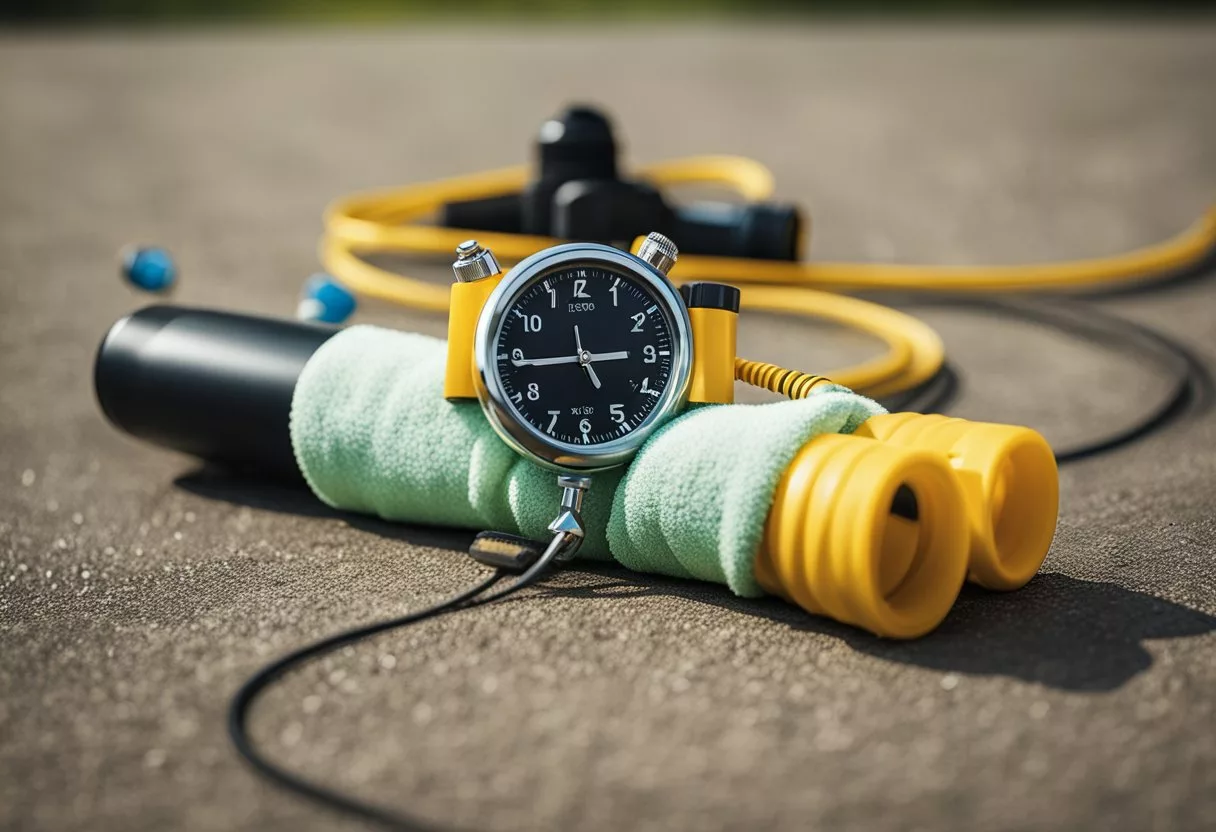Jumping rope is an activity that most people associate with childhood, but it’s also an effective exercise for adults. Not only is it a fun way to get moving, but it can also offer a variety of benefits for your body. In this article, we will explore what happens to your body if you jump rope every day.

Jumping rope is a high-impact exercise that is great for cardiovascular health. It can help to improve your heart health by increasing your heart rate and promoting blood flow throughout your body. Additionally, jumping rope can help to improve your coordination and balance, as well as your overall fitness level.
While jumping rope may seem like a simple activity, it can actually be quite challenging. It requires a lot of energy and stamina, which means that it can help to burn calories and promote weight loss. Additionally, jumping rope can help to tone your muscles, particularly in your legs and core. Overall, jumping rope is a great way to get in shape and improve your health.
Understanding Jump Rope as an Exercise
Jump rope is a simple, yet effective exercise that can provide numerous benefits to the body. It involves jumping over a rope that is swung over the head and under the feet. This exercise can be performed by people of all ages and fitness levels, making it an ideal choice for those who want to improve their health and fitness.
Benefits of Jumping Rope
Jumping rope is a great way to improve cardiovascular health, as it elevates the heart rate and engages multiple muscle groups. It is a full-body workout that engages the arms, core, abs, chest, quadriceps, glutes, calves, hip flexors, and foot muscles. By jumping rope every day, these muscles will gain strength and power, leading to improved muscular endurance.
Jumping rope is also an effective way to burn calories and lose weight. According to a study published in the Research Quarterly for Exercise and Sport, jumping rope for 10 minutes burns the same number of calories as jogging for 30 minutes. This makes it an ideal choice for those who want to get a quick and effective workout in a short amount of time.
Jump Rope vs. Other Cardio Exercises
Jumping rope is a low-impact exercise that is easier on the joints than running. It is also a more versatile exercise, as it can be performed indoors or outdoors, and requires minimal equipment. This makes it an ideal choice for those who want to get a good workout without having to go to the gym or invest in expensive equipment.
Types of Jump Ropes and Equipment
There are several types of jump ropes available, including speed ropes, weighted ropes, and beaded ropes. Speed ropes are designed for fast, rapid jumping, while weighted ropes add resistance and can help build strength. Beaded ropes are a good choice for beginners, as they are easier to control and provide feedback on proper form.
In addition to jump ropes, there are several other types of equipment that can be used to enhance a jump rope workout. These include foam mats for shock absorption, wrist weights for added resistance, and ankle weights for a more challenging workout.
Overall, jumping rope is a simple, yet effective exercise that can provide numerous benefits to the body. By incorporating this exercise into a daily routine, individuals can improve their cardiovascular health, build strength and endurance, and burn calories.
Physical Health Improvements

Jumping rope every day can have a positive impact on physical health. The following subsections will explore the specific ways in which jumping rope can improve cardiovascular health, strength and muscle development, bone density and joint health, and weight management.
Cardiovascular Health
Jumping rope is a form of cardiovascular exercise that can help improve heart health. According to Cleveland Clinic[1], jumping rope can increase heart rate, which in turn strengthens the heart muscle and improves blood flow throughout the body. This can help reduce the risk of heart disease and other cardiovascular conditions.
Strength and Muscle Development
Jumping rope engages multiple muscle groups, including the quadriceps, glutes, calves, abdominals, hip flexors, and foot muscles. Over time, regular jumping rope can lead to improved muscular strength and power in these areas. This can lead to better overall physical performance and reduced risk of injury.
Bone Density and Joint Health
Jumping rope is a weight-bearing exercise that can help improve bone density and joint health. According to Elite Jumps[2], regular jumping rope can help stimulate the production of bone cells, which can help prevent conditions such as osteoporosis. Additionally, jumping rope can help improve joint stability and reduce the risk of injury.
Weight Management
Jumping rope is a high-intensity exercise that can help burn calories and aid in weight management. According to GoodRx[3], jumping rope can burn up to 10 calories per minute, making it an effective form of cardio for weight loss. Additionally, jumping rope can help improve overall body composition by reducing body fat and increasing muscle mass.
In conclusion, jumping rope every day can have a positive impact on physical health. Regular jumping rope can lead to improved cardiovascular health, strength and muscle development, bone density and joint health, and weight management.
Enhancements in Physical Abilities
Jumping rope every day can lead to several improvements in physical abilities, such as balance, coordination, agility, speed, endurance, and muscular endurance.
Balance and Coordination
Jumping rope requires a high level of coordination between the eyes, hands, and feet. Regular practice of jumping rope can improve motor coordination and balance, which can help reduce the risk of falls and injuries.
Agility and Speed
Jumping rope involves quick and precise movements, which can help improve agility and speed. It can also enhance footwork and reaction time, which are essential skills for many sports and activities.
Endurance and Stamina
Jumping rope is an excellent cardiovascular exercise that can improve endurance and stamina. It can increase the heart rate and oxygen consumption, which can help improve overall fitness levels. Regular practice of jumping rope can also lead to improvements in muscular endurance, particularly in the legs and core muscles.
In conclusion, jumping rope every day can lead to several enhancements in physical abilities, including balance, coordination, agility, speed, endurance, and muscular endurance. It is a low-impact exercise that can be done anywhere, making it an excellent addition to any workout routine.
Mental and Emotional Benefits
Jumping rope not only has physical benefits but also has mental and emotional benefits. Here are some of the ways jumping rope can benefit your mental and emotional health:
Stress Reduction and Mental Health
Jumping rope can help reduce stress and improve mental health. According to a study published in the Journal of Sport and Exercise Psychology, jumping rope can be an effective form of exercise for reducing stress and improving mood. It can also boost endorphins, which are the body’s natural feel-good chemicals.
Cognitive Function and Attention
Jumping rope can also improve cognitive function and attention. A study published in the Journal of Human Movement Science found that jumping rope can improve cognitive function, including attention, working memory, and information processing speed. It can also help improve hand-eye coordination and reaction time.
In addition to the physical and mental benefits, jumping rope can also be meditative practice. The repetitive motion of jumping rope can help calm the mind and improve focus. It can also boost confidence and self-esteem, as you improve your skills and achieve your fitness goals.
Overall, jumping rope is a great way to improve both physical and mental health. Incorporating it into your daily routine can help reduce stress, improve mood, and boost cognitive function and attention.
Technique and Workout Integration

Proper Form and Technique
Jumping rope is a simple exercise, but proper form and technique are essential to avoid injury and maximize the benefits. To start, stand with your feet shoulder-width apart and hold the handles of the rope at waist level. Keep your elbows close to your body and your wrists relaxed. As you jump, use your wrists to spin the rope and jump only high enough to clear the rope. Land on the balls of your feet and keep your knees slightly bent to absorb the impact.
Incorporating Jump Rope into Workout Routines
Jump rope can be a great addition to any workout routine. It is an effective way to improve cardiovascular health, burn calories, and build endurance. One way to incorporate jump rope into a workout routine is to use it as a warm-up before strength training or HIIT workouts. Jump rope for 5-10 minutes to get your heart rate up and your muscles warmed up.
Another way to use jump rope in a workout routine is to incorporate it into interval training. Alternate between jumping rope and other exercises, such as push-ups or squats, to create a high-intensity workout that targets multiple muscle groups.
Warm-Up and Cool-Down Strategies
Just like any other workout, it is important to warm up and cool down properly when jumping rope. Before starting, perform some dynamic stretches, such as leg swings or arm circles, to get your muscles ready for the workout. After jumping rope, perform some static stretches, such as hamstring stretches or quad stretches, to help your muscles recover.
In conclusion, jumping rope is a simple and effective way to improve cardiovascular health, burn calories, and build endurance. Proper form and technique are essential to avoid injury and maximize the benefits, and jump rope can be easily integrated into any workout routine. Remember to warm up and cool down properly to get the most out of your jump rope workout.
Considerations and Precautions

Age and Fitness Level Considerations
Jumping rope is a low-impact exercise that can be done by people of all ages and fitness levels. However, it is important to consider one’s own physical limitations and adjust the intensity and duration of the workout accordingly. For example, people with joint problems or injuries may need to modify their jumping technique or avoid certain types of jumps altogether.
The American Heart Association recommends that adults engage in at least 150 minutes of moderate-intensity aerobic exercise per week, or 75 minutes of vigorous-intensity aerobic exercise per week. Jumping rope can be a great way to meet these recommendations, but it is important to start slowly and gradually increase the intensity and duration of the workout.
Injury Prevention and Safety Tips
Jumping rope is generally a safe and low-risk exercise, but there are some precautions that should be taken to prevent injury. It is important to wear proper footwear with good support and cushioning to protect the feet and ankles. A flat and non-slip surface should also be used to prevent slips and falls.
To prevent overuse injuries, it is important to vary the types of jumps and movements used during the workout. It is also recommended to warm up before and cool down after the workout to prevent muscle strains and other injuries.
When to Consult Healthcare Providers
Jumping rope is generally safe for most people, but there are some cases where it may not be recommended. People with high blood pressure or other cardiovascular conditions should consult with their healthcare provider before starting a jumping rope routine. Pregnant women should also consult with their healthcare provider before starting any new exercise routine.
If any pain or discomfort is experienced during or after jumping rope, it is important to stop the exercise and consult with a healthcare provider. Injuries such as sprains or strains should also be evaluated by a healthcare provider to determine the appropriate treatment plan.
Lifestyle Factors and Performance

Nutrition and Hydration
Jumping rope every day can be a demanding exercise, and proper nutrition and hydration are essential for optimal performance and recovery. A balanced diet that includes complex carbohydrates, lean proteins, and healthy fats can provide the necessary energy to fuel the body during exercise. It is also important to stay hydrated by drinking plenty of water throughout the day, especially before and after exercise.
Sleep and Recovery
Getting enough sleep and rest is crucial for overall wellness and exercise performance. Adequate sleep can help the body recover from exercise and reduce the risk of injury. Lack of sleep can lead to fatigue, decreased motivation, and poor exercise performance. It is recommended that adults aim for 7-9 hours of sleep per night.
Exercise Consistency and Habit Building
Consistency is key when it comes to exercise and building healthy habits. Jumping rope every day can help establish a consistent exercise routine and promote habit-building. However, it is important to listen to the body and avoid overtraining or pushing too hard. Gradually increasing the intensity and duration of jump rope sessions can help prevent injury and promote long-term success.
Incorporating lifestyle factors such as proper nutrition, hydration, sleep, and exercise consistency can help enhance jump rope performance and overall wellness. By prioritizing these factors, individuals can optimize their exercise routine and achieve their fitness goals.
Adaptability and Accessibility

Jump Rope for Travel and Limited Spaces
Jump rope is a versatile exercise that can be done almost anywhere. It’s an ideal exercise for those who travel frequently or have limited space. Jumping rope requires very little equipment and can be done indoors or outdoors. All that is needed is a jump rope and enough space to move around without hitting anything.
For those who travel frequently, a jump rope is a compact and lightweight piece of exercise equipment that can easily fit in a suitcase or carry-on bag. Jumping rope is an effective way to stay active while on the road. It can be done in a hotel room, a park, or any other open space.
Jump rope is also an ideal exercise for those who live in small apartments or have limited space. It can be done in a small living room or even in a hallway. Jumping rope is a great way to get a full-body workout without taking up a lot of space.
Adapting Jump Rope for Different Skill Levels
Jump rope is a great exercise for people of all skill levels. Whether you are a beginner or an advanced athlete, there are ways to adapt jump rope to your skill level.
For beginners, it’s important to start slow and focus on proper form. It’s also important to choose the right jump rope. A heavier jump rope can be easier for beginners to control, while a lighter jump rope can be more challenging.
For more advanced athletes, there are many ways to make jump rope more challenging. One way is to increase the speed of the rope. Another way is to add in different jump rope techniques, such as double unders or crossovers.
Jump rope is also a great exercise for people with different fitness goals. For those looking to improve their cardiovascular endurance, jumping rope can be done for longer periods of time with shorter rest periods. For those looking to build muscle, jumping rope can be combined with other exercises, such as push-ups or squats.
Overall, jump rope is a versatile exercise that can be adapted to fit the needs and goals of anyone. It’s a great exercise for those who travel frequently or have limited space, and it can be adapted to fit the skill level of anyone.
References
- 6 Benefits of Jumping Rope for Your Overall Health. https://health.clevelandclinic.org/jump-rope-benefits Accessed October 29, 2025
- 14 Benefits Of Jumping Rope Daily – Elite Jumps. https://elitejumps.co/blogs/guides/surprising-benefits-of-jump-rope Accessed October 29, 2025
- Access to this page has been denied. https://www.goodrx.com/well-being/movement-exercise/benefits-of-jumping-rope Accessed October 29, 2025
